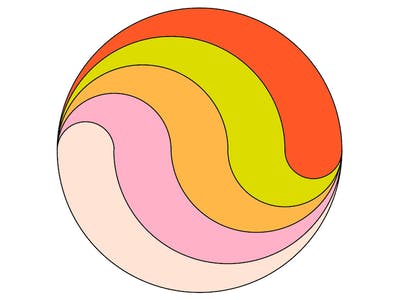Is it possible to divide a circle into n parts of equal area using only a straightedge and compasses?
Puzzles
Counter Play 2

Lee Sallows sent this clever puzzle, a followup to one we presented in 2010:
In the square shown above, any 3 counters in a straight line sum to 15.
Puzzle: Reposition the counters (again, one to each cell) to produce a new square again showing eight collinear triplets summing to 15, but with 1 now placed in a corner square.
Black and White

A densely imaginative little problem by Joseph C.J. Wainwright. White to mate in two moves.
“To My Pupil”
Lewis Carroll’s 1885 puzzle book A Tangled Tale bears an anonymous dedication:
Beloved Pupil! Tamed by thee, Addish-, Subtrac-, Multiplica-tion, Division, Fractions, Rule of Three, Attest thy deft manipulation! Then onward! Let the voice of Fame From Age to Age repeat thy story, Till thou has won thyself a name Exceeding even Euclid's glory!
He was thinking of Edith Rix, a child-friend who went on to study mathematics at Cambridge. She might have divined without asking that the dedication was intended for her. How?
Exercise
In his later years Lewis Carroll would while away sleepless hours by solving mathematical problems in his head. Eventually he published 72 of these as Pillow Problems (1893). “All of these problems I thought up in bed, solving them completely in my head, and I never wrote anything down until the next morning.” Can you solve this one?
Prove that 3 times the sum of 3 squares is also the sum of 4 squares.
Audition

In January 1942, a series of letters to the Daily Telegraph complained that the newspaper’s crossword was too easy — anyone might solve it in a matter of minutes, they said. Accordingly the chairman of a London club offered to donate £100 to charity if anyone could solve a given crossword in 12 minutes. Editor Arthur Watson arranged a competition in the paper’s Fleet Street newsroom, and five people won the competition (though the fastest was later disqualified for misspelling a word). Several were later hired to work at Bletchley Park breaking German military codes.
The Telegraph published the “time test” puzzle later that month, and presented it again in 2014, inviting readers to try to solve it in 12 minutes. “Could you have been a codebreaker at Bletchley Park?”
Geography
Brad Taylor offered this baseball puzzle in the October 2001 issue of MIT Technology Review:
The Red Sox beat the Orioles 9 to 4 in 17 innings. Where was the game played?
Black and White

I don’t know who came up with this, but I thought it was cute. Can White checkmate Black in two moves from this position?
Unwholesome
Red and Blue
A problem from the 1996-1997 Estonian Mathematical Olympiad:
A square tabletop measures 3n × 3n. Each unit square is either red or blue. Each red square that doesn’t lie at the edge of the table has exactly five blue squares among its eight neighbors. Each blue square that doesn’t lie at the edge of the table has exactly four red squares among its eight neighbors. How many squares of each color make up the tabletop?


